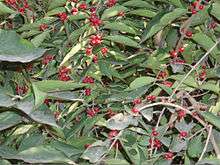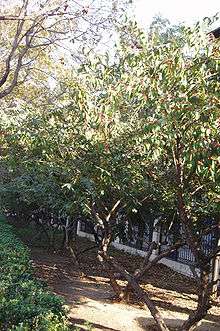Lonicera maackii
Lonicera maackii, the Amur honeysuckle, is a species of honeysuckle in the family Caprifoliaceae that is native to temperate western Asia, specifically in northern and western China south to Yunnan, Mongolia, Primorsky Krai in southeastern Russia, Korea, and, albeit rare there, central and northern Honshū, Japan.[2]
| Lonicera maackii | |
|---|---|
 | |
| Scientific classification | |
| Kingdom: | Plantae |
| Clade: | Tracheophytes |
| Clade: | Angiosperms |
| Clade: | Eudicots |
| Clade: | Asterids |
| Order: | Dipsacales |
| Family: | Caprifoliaceae |
| Genus: | Lonicera |
| Species: | L. maackii |
| Binomial name | |
| Lonicera maackii (Rupr.) Maxim. | |
| Synonyms[1] | |
| |
Lonicera maackii is enumerated as an endangered species in Japan.[3][4] It has escaped from cultivation and naturalized in New Zealand and the eastern United States; in the woodlands of the latter it is a significant invasive species.[5]
The plant is a large, deciduous shrub that grows a maximum of 6 m tall with stems of a maximum of 10 cm in diameter. The leaves are oppositely arranged, 5–9 cm long and 2–4 cm broad, with an entire margin, and with at least some rough pubescence. The flowers are produced in pairs, and commonly several pairs are produced together in clusters; they are 2 cm long, have two lips, begin white and later turn yellow or pale orange in color; they bloom from middle of spring to early summer. The fruit is a bright red to black, semi-translucent berry, 2–6 mm in diameter, that contains numerous small seeds; they ripen in autumn and are eaten by birds, which disperse the seeds in their droppings.
It grows rapidly and prefers shady habitats such as woodland understories, neglected urban areas, and fence rows. It can form very dense thickets.[6][7][8]

Cultivation
Amur honeysuckle is cultivated as an ornamental plant for its attractive flowers and as a hedge. Many cultivars have been selected for horticulture, including 'Erubescens' with pink flowers and 'Rem Red' with an erect form.[6]
The flowers are sometimes savored by children, who remove blossoms and pull off their bottoms so as to suck out the sweet nectar in the centers. However, the berries are mildly poisonous to humans and therefore should not be consumed.
Invasive nature and remedies

Propagation of this plant is illegal or controlled in some of the United States, where it is an alien species, because of its well documented invasive nature.[5][7][9][10][11] The species is named "invasive, banned" in Connecticut, "prohibited" in Massachusetts, as an invasive species in Tennessee, as an invasive species in Ohio, as a "Class B noxious weed" in Vermont, and as an invasive species in Wisconsin.[12]
This plant is adaptable and flourishes in a wide range of conditions. In the United States, it was historically planted to control erosion and in hedges. It propagated itself rapidly by avian dispersion of its seeds and soon thereafter naturalized. Notably, in the understories of deciduous woodlands of the eastern United States it forms dense thickets, the shade of whose canopies prevent the growth of native shrubs, juvenile trees, and wild flowers.[5][7][9][10][11] Uncontrolled, these growths result in almost monocultural thickets of Amur honeysuckle.[5][7][9][10][11] The species gravely jeopardizes not only the diversity of the invaded ecosystems but even the regeneration of woodlands,[5][7][9][10][11] because it reduces the growth and diversity of native seedlings.[13] Additionally, studies indicate that it negatively affects birds[14] and tadpoles.[15] Even if its shrubs are removed, the affected habitat may not recover absent substantial human effort.[16] A study conducted in the vicinity of St. Louis, Missouri in 2010 indicated that the plant increases the risk of tick-borne diseases such as Erlichiosis and Lyme disease in suburban natural areas by attracting deer and consequently increasing the presence of infected ticks. Furthermore, experimental removal of the plant was shown to reduce deer activity and the number of infected ticks by shifting ticks' blood meals from deer.[17]
The species is controlled by cutting, flaming, or burning the plant to the level of its roots and repetition of this in two-week increments until the nutrient reserves in the roots are depleted. To ensure eradication, herbicide may be applied to freshly cut stumps. Control by prescribed burning has been found to be most effective during the phase of seed dispersal in late summer and early autumn.[5] It is also controlled by annual applications of glyphosate that thoroughly saturate the foliage or by grubbing the shallowly rooted juvenile plants, but these two methods require increased cost of labor and disruption of the soil.
Because of the invasive nature of this species, it may be imprudent to cultivate this plant in places whose climates are similar to those where the species has invaded, e. g. the eastern United States.[9] It has been suggested that alien specimens beyond their native range in eastern Asia should be removed and replaced by non-invasive alternatives.[11] Possible fast growing, shade tolerant, deciduous, alternative shrubs include Calycanthus floridus, Cornus mas, Cornus sericea, Forsythia hybrids, Hydrangea species, Syringa vulgaris, Viburnum cassinoides, Viburnum dentatum, Viburnum dilatatum, Viburnum opulus, Viburnum prunifolium, Viburnum trilobum, and Weigela florida.[11] Other alternative native shrubs for the Midwestern United States are enumerated in "Curse of the Bush Honeysuckles!" from the Missouri Department of Conservation.[18]
Etymology and authority
The specific epithet "maackii" is derived from Richard Maack, a Russian naturalist of the 19th century.[11] The common name "Amur honeysuckle" derives from the Amur River, which demarcates the border between the Russian Far East and Manchuria in China; the native range of the species is an area surrounding the river.
Some Internet sources incorrectly name the species authority as "(Rupr.) Herder", but the correct authority is "(Rupr.) Maxim".[2]
References
| Wikimedia Commons has media related to Lonicera maackii. |
- "The Plant List: A Working List of All Plant Species". Retrieved 7 December 2014.
- "Lonicera maackii". Germplasm Resources Information Network (GRIN). Agricultural Research Service (ARS), United States Department of Agriculture (USDA). Retrieved 2 January 2018.
- Ministry of the Environment (Japan): Red List of Threatened Plants of Japan (Excel spreadsheet)
- Red Data Book (Japan): Lonicera maackii Archived 2011-06-15 at the Wayback Machine (in Japanese, with map; google translation)
- "USDA Forest Service Weed of the Week Fact Sheet (PDF file)" (PDF).
- Huxley, A., ed. New RHS Dictionary of Gardening. Macmillan, 1992. ISBN 0-333-47494-5.
- Missouriplants: Lonicera maackii
- Invasive.org: Lonicera species (PDF file) Archived 2006-09-28 at the Wayback Machine
- Annotated Bibliography of Primary Research on Invasive Qualities of L. maackii in the USA: National Biological Information Infrastructure Archived 2007-05-13 at Archive.today
- University of Connecticut Plant Database: L. maackii Archived 2007-05-10 at the Wayback Machine
- Ohio State University Pocket Gardener: L. maackii Archived 2007-07-14 at the Wayback Machine
- USDA PLANTS DATABASE: L. maackii
- Gorchov, David L.; Trisel, Donald E. (1 May 2003). "Competitive effects of the invasive shrub, Lonicera maackii (Rupr.) Herder (Caprifoliaceae), on the growth and survival of native tree seedlings". Plant Ecology. 166 (1): 13–24. doi:10.1023/A:1023208215796.
- Schmidt, Kenneth A.; Whelan, Christopher J. (1 December 1999). "Effects of Exotic Lonicera and Rhamnus on Songbird Nest Predation". Conservation Biology. 13 (6): 1502–1506. doi:10.1046/j.1523-1739.1999.99050.x.
- Watling, J. I.; Hickman, C. R.; Lee, E.; Wang, K.; Orrock, J. L. (1 January 2011). "Extracts of the invasive shrub Lonicera maackii increase mortality and alter behavior of amphibian larvae". Oecologia. 165 (1): 153–159. doi:10.1007/s00442-010-1777-z. PMID 20938785.
- Rodewald, A.D.; et al. (2015). "Does Removal of Invasives Restore Ecological Networks? An Experimental Approach". Biological Invasions. 17 (7): 2139–2146. doi:10.1007/s10530-015-0866-7.
- Allan, Brian F.; Dutra, Humberto P.; Goessling, Lisa S.; Barnett, Kirk; Chase, Jonathan M.; Marquis, Robert J.; Pang, Genevieve; Storch, Gregory A.; Thach, Robert E.; Orrock, John L. (26 October 2010). "Invasive honeysuckle eradication reduces tick-borne disease risk by altering host dynamics". Proceedings of the National Academy of Sciences. 107 (43): 18523–18527. doi:10.1073/pnas.1008362107. PMC 2973004. PMID 20937859 – via www.pnas.org.
- "Curse of the Bush Honeysuckles!" (PDF). Missouri Department of Conservation.